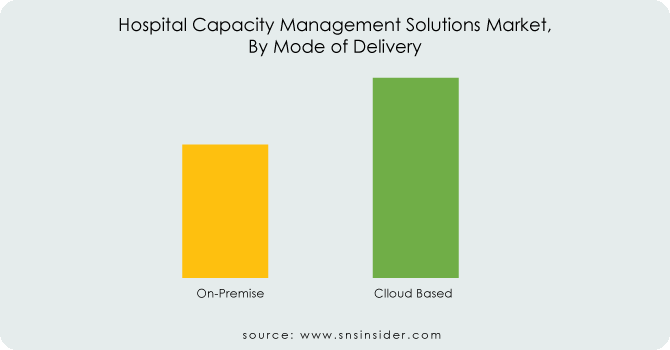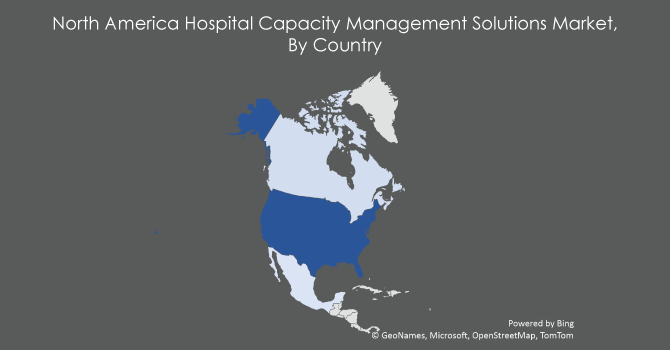Hospital Capacity Management Solutions Market Report Scope & Overview:
The Hospital Capacity Management Solutions Market Size was valued at USD 4.17 billion in 2023, and expected to reach USD 14.85 billion by 2031 and grow at a CAGR of 17.2% over the forecast period 2024-2031.
A digital revolution is sweeping healthcare, driven by automation and the Internet of Things (IoT). Hospital Capacity Management Systems (HCMS) are leading the charge, reducing costs through streamlined operations and fewer errors. Studies show a 20% reduction in patient readmissions with HCMS, and optimized bed allocation further saves money. Governments are recognizing the value of digital health in controlling costs, making HCMS even more attractive.

Get more information on Hospital Capacity Management Solutions Market - Request Sample Report
But HCMS goes beyond beds. It factors in staffing, crucial given a projected global nurse shortage of 10 million by 2030. Security concerns with patient data are valid, but multi-layered security measures can mitigate risks. User-friendly dashboards and real-time data empower staff, reducing errors and potentially shortening hospital stays. A growing elderly population and more pediatric patients further highlight the need for healthcare tech. By 2030, a significant portion, estimated to be 1 in 6 people, will be over 60 years old. This translates to a staggering growth from 1 billion in 2020 to 1.4 billion by 2030. Looking further ahead, this trend continues, with the number of people over 60 projected to double by 2050, reaching a staggering 2.1 billion. This, along with the cost savings and improved care offered by HCMS, will undoubtedly fuel continued growth in the market.
MARKET DYNAMICS
KEY DRIVERS:
-
There is a pressing need to control or mitigate the rising costs of healthcare
Governments and healthcare systems worldwide are grappling with escalating costs. To combat this challenge, they're increasingly turning to hospital capacity management software. These solutions, encompassing workforce and asset management, aim to streamline operations and reduce waste.
Effective implementation can save billions by minimizing patient readmissions, medical errors, and administrative burdens. Improper patient placement and scheduling delays are costly inefficiencies that capacity management solutions effectively address. Ultimately, these tools empower healthcare systems to deliver quality care at a sustainable price point.
RESTRAIN:
-
Limitations in developing countries' information technology infrastructure
While the initial cost is high, hidden expenses can quickly multiply. Frequent maintenance and updates often exceed the initial purchase price. Ongoing technical support and user training are essential but add to the bottom line. Finally, the healthcare industry may lack internal IT expertise, requiring additional training, further inflating the total cost of ownership. These hidden costs can be a significant barrier, especially for resource-limited institution.
OPPORTUNITY:
-
Optimizing healthcare resource allocation through IoT-powered capacity management
New tools like the Internet of Things (IoT) are creating a boom for healthcare capacity management. Imagine a network of smart sensors monitoring everything from cold storage to medical equipment. This real-time data gives hospitals a clear view of their operations, allowing them to optimize resource allocation and track equipment performance.
CHALLENGES:
-
Challenges in safeguarding healthcare data security and privacy
While IoT devices offer exciting possibilities for healthcare, they also introduce new security vulnerabilities. Hospitals often have numerous IoT devices on a single network, creating a complex system with multiple entry points. These networks may connect to external systems like ultrasound machines and tracking devices, potentially introducing additional security risks.
Sensitive patient data transmitted across these networks could be intercepted by unauthorized parties, including government agencies, data collectors, or even hackers. This not only breaches patient privacy but can also pose a security threat to both the individual and the healthcare organization.
IMPACT OF RUSSIA UKRAINE WAR
The Russia-Ukraine war disrupted the Hospital Capacity Management Solutions (HCMS) market. It disrupted supply chains could delay implementations by months and inflate costs by 5-10%. Meanwhile, a global economic slowdown might decrease investments in HCMS by 5-10%.
War-torn regions like Ukraine could see a 20-30% surge in HCMS demand to manage patients and resources. Furthermore, the war's emphasis on healthcare preparedness may lead to increased HCMS adoption in other countries, potentially fueled by emergency healthcare funding.
IMPACT OF ECONOMIC SLOWDOWN
A economic slowdown presents a mixed bag for the Hospital Capacity Management Solutions (HCMS) market. Budgets cuts could lead to a 5-10% decrease in HCMS investments, with hospitals prioritizing essential spending. Private providers might also see a 10-15% decline in demand for these solutions.
The economic pressure to optimize costs could be a boon for HCMS. These solutions can potentially cut costs by 10-15% through streamlined operations and resource allocation, making them more attractive. Additionally, governments might offer incentives like grants or tax breaks to encourage HCMS adoption, further stimulating the market.
KEY MARKET SEGMENTATION:
By Product Type
-
Asset Management
-
Bed Management
-
Medical Equipment Management
-
-
-
Leave and Absence Management
-
Nursing & Staff Scheduling Solutions
-
-
Quality Patient Care
The asset management solutions sector accounted for the greatest market share among product segments in 2022. The growing emphasis on efficient management and storage of healthcare equipment is responsible for the substantial proportion of this market. Government incentives, sanctions, and the need to cut healthcare costs are all helping to drive this market segment forward.
By Component Type
-
Software
-
Standalone
-
Integrated
-
-
Services
By Mode of delivery
-
On-premise
-
Cloud-based

Need any customization research on Hospital Capacity Management Solutions Market - Enquiry Now
By End-User
-
Hospitals
-
Ambulatory Surgical Centers
-
Surgical Centers
REGIONAL ANALYSIS
The Asia-Pacific region is the fasest growing hospital capacity management solutions market. This market is experiencing the fastest growth globally, fueled by a confluence of factors. Government initiatives are actively promoting digital healthcare (eHealth), making these solutions more accessible. Additionally, a booming medical tourism industry and the ongoing emphasis on efficient resource management post-pandemic are driving adoption.
The US dominates the North American market for hospital capacity management solutions, holding an estimated 88% share in 2023. This lead is driven by factors like a growing number of hospitals for chronic diseases, a rising elderly population, and the prevalence of chronic conditions itself. With millions of Americans battling chronic illnesses, extended hospital stays and slower recoveries are common, creating a strong demand for solutions that optimize hospital capacity.

REGIONAL COVERAGE:
North America
-
US
-
Canada
-
Mexico
Europe
-
Eastern Europe
-
Poland
-
Romania
-
Hungary
-
Turkey
-
Rest of Eastern Europe
-
-
Western Europe
-
Germany
-
France
-
UK
-
Italy
-
Spain
-
Netherlands
-
Switzerland
-
Austria
-
Rest of Western Europe
-
Asia Pacific
-
China
-
India
-
Japan
-
South Korea
-
Vietnam
-
Singapore
-
Australia
-
Rest of Asia Pacific
Middle East & Africa
-
Middle East
-
UAE
-
Egypt
-
Saudi Arabia
-
Qatar
-
Rest of Middle East
-
-
Africa
-
Nigeria
-
South Africa
-
Rest of Africa
-
Latin America
-
Brazil
-
Argentina
-
Colombia
-
Rest of Latin America
KEY PLAYERS:
Some of the major key players are as follows: Infosys Limited, Tele Tracking Technologies, Inc, McKesson Corporation, STANLEY Healthcare Solutions Limited, Care Logistics, HealthStream, Sonitor Technologies, Inc, Epic Systems Corp, JVS Group and Cerner Corporation and Other Players.
RECENT TRENDS
-
In November 2021, Allscripts partnered with Next Level Urgent Care to enhance their network's connectivity, streamline electronic health record (EHR) processes, and boost data analytics capabilities across all their facilities.
-
In December 2021, McKesson Corporation announced the sale of its Austrian business to Quadrifolia Management GmbH (Quadrifolia).
Tele Tracking Technologies Inc-Company Financial Analysis

| Report Attributes | Details |
|---|---|
| Market Size in 2023 | US$ 4.17 Billion |
| Market Size by 2031 | US$ 14.85 Billion |
| CAGR | CAGR of 17.2% From 2024 to 2031 |
| Base Year | 2023 |
| Forecast Period | 2024-2031 |
| Historical Data | 2021-2022 |
| Report Scope & Coverage | Market Size, Segments Analysis, Competitive Landscape, Regional Analysis, DROC & SWOT Analysis, Forecast Outlook |
| Key Segments | • By Product Type [Asset Management (Bed Management, Medical Equipment Management), Patient Flow Management Solutions, Workforce Management (Leave and Absence Management, Nursing & Staff Scheduling Solutions), Quality Patient Care] • By Component Type [Software (Standalone, Integrated), Services] • By Mode of delivery (On-premise, Cloud-based) • By End-User (Hospitals, Ambulatory Surgical Centers, Surgical Centers) |
| Regional Analysis/Coverage | North America (US, Canada, Mexico), Europe (Eastern Europe [Poland, Romania, Hungary, Turkey, Rest of Eastern Europe] Western Europe] Germany, France, UK, Italy, Spain, Netherlands, Switzerland, Austria, Rest of Western Europe]), Asia Pacific (China, India, Japan, South Korea, Vietnam, Singapore, Australia, Rest of Asia Pacific), Middle East & Africa (Middle East [UAE, Egypt, Saudi Arabia, Qatar, Rest of Middle East], Africa [Nigeria, South Africa, Rest of Africa], Latin America (Brazil, Argentina, Colombia Rest of Latin America) |
| Company Profiles | Infosys Limited, Tele Tracking Technologies, Inc, McKesson Corporation, STANLEY Healthcare Solutions Limited, Care Logistics, HealthStream, Sonitor Technologies, Inc, Epic Systems Corp, JVS Group and Cerner Corporation |
| DRIVERS |
• There is a pressing need to control or mitigate the rising costs of healthcare. |
| RESTRAINTS | • Limitations in developing countries' information technology infrastructure. |

